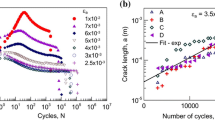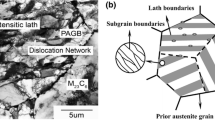Abstract
Cyclic response and fatigue damage have been studied on precipitation-hardened Al-4 pet Cu alloy as a function of particle type and spacing by means of scanning and transmission electron microscopy. Specimens strain cycled in tension-compression under controlledplastic-strain tests formed intense intragranular slip bands by a disordering mechanism when the microstructures contained precipitates penetrable by dislocations. These bands were the sites of crack nucleation and Stage I propagation. With the addition of impenetrable particles, slip was dispersed homogeneously; consequently, crack nucleation and Stage I propagation shifted to the grain boundaries. The cyclic response results were then applied to Tomkins’ model of fatigue life prediction. It was found that his equations were a conservative estimate of the actual results.
Similar content being viewed by others
References
P. J. E. Forsyth:The Physical Basis of Fatigue, American Elsevier Pub. Co., New York, N. Y., 1969.
International Conference on Fatigue: ASME and Inst. Mech. Eng., London, 1956.
C Calabrese and C Laird:Mat. Sci. Eng., Part 1, 1974, vol. 13, pp. 141–57.
C Calabrese and C Laird:Mat. Sci. Eng., Part II, 1974, vol. 13, 1974, pp. 159–74.
Calabrese: Ph.D. Thesis, University of Pennsylvania, Philadelphia, Pennsylvania, 1972.
C. Laird and D. J. Duquette:Corrosion Fatigue, 0. F. Devereux, A. J. McEvily, and R. W. Staehle, eds., pp. 88–117, NACE, 1972.
Laird: Fatigue Crack Propagation, pp. 131–80, ASTM STP 415, ASTM, Philadelphia, Pennsylvania, 1967.
H. Wells and P. Sullivan:Trans. ASM, 1964, vol. 57, pp. 841–55.
M. A. Miner:App. Mech., 1945, vol. 12, pp. 159–64.
S. S. Manson:Thermal Stress and Low Cycle Fatigue, McGraw-Hill Book Co., New York, N. Y., 1966.
D. T. Raske and J. Morrow:Manual on Low Cycle Fatigue, pp. 1–26, ASTM STP 465, ASTM, Philadelphia, Pennsylvania, 1969.
R. W. Landgraf:Achievement of High Fatigue Resistance in Metals and Alloys, pp. 3–36, ASTM STP 467, ASTM, Philadelphia, Pennsylvania, 1970.
J. Grosskreutz:Fatigue and Fracture of Aircraft Structures and Materials, N.T.I.S., Report No. AD 719 756,47,1969.
J. T. Berling and J. Conway:Met. Trans., 1970, vol. 1, pp. 805–09.
J. Morrow:Internal Friction, Damping and Cyclic Plasticity, pp. 45–87, ASTM STP 375, ASTM, Philadelphia, Pennsylvania, 1965.
F. Erdogan:Crack Propagation Theories, NASA-CR-901, Nat. Aero, and Space Adm., Washington, D.C., 1967.
B. A. Bilby and K. H. Swinden:Proc. Roy. Soc., 1965, vol. 285, pp. 22–3.
R. W. Lardner:Phil Mag, 1968, vol. 17, no. 145, pp. 71–82.
H. W. Liu and I. Nobu:Fracture, pp. 812–18, Chapman and Hall Ltd., London, 1969.
B. Tomkins:Phil. Mag., 1968, vol. 18, pp. 1041–66. or]21.|B. Tomkins, G. Summer, and J. Wareing: Fracture, 1969, pp. 712–14.
C. Laird and A. R. Krause:Inelastic Behavior of Solids, pp. 691–715, McGrawHill Book Co., New York, N. Y., 1970.
J. Hickerson and R. W. Hertzberg:Met. Trans., 1972, vol. 3, pp. 179–189.
L. P. Karjalaimen:Met. Sci. J., 1972, vol. 6, pp. 195–99.
E. Feltner and M. R. Mitchell:Manual on Low Cycle Fatigue Testing, pp. 27–66, ASTM STP 465, ASTM, Philadelphia, Pennsylvania, 1969.
J. M. Silcock, T. J. Heal, and H. Hardy:J. Inst. Met., 1953-54, vol. 82, pp. 239–51.
A. Kelly and R. B. Nicholson:Progress in Materials Science, vol. 10, MacMillan Co., New York, N. Y., 1963.
H. Y. Hunsicker:Aluminum, 3rd ed., vol. 1, pp. 109–62, ASM, Metals Park, Ohio, 1968.
M. E. Fine:Strengthening of Metals, pp. 141–62, Reinhold Publishing Corp., New York, N. Y., 1964.
J. Grosskreutz:Metal Fatigue Damage, ASTM STP 495, pp. 5–60, ASTM, Philadelphia, Pennsylvania, 1971.
W. J. Plumbridge and D. A. Ryder:Met. Mater. Metallurg. Rev., 1969, vol. 3, no. 8, pp. 119–42.
J. Grosskreutz:J. Phys. Status. Solidi, 1971, vol. 47, pp. 359–96.
J. M. Finney:Mater. Sci. Eng., 1970, vol. 6, pp. 55–65.
J. Grosskreutz: Relation Between Heat Treatment, Microstructure, and Fatigue in Structural Materials, Met. Soc. AIME, Atlanta, Ga., May 17–20, 1971.
Laird and E. Feltner:Trans. TMS-AIME, 1967, vol. 239, pp. 1074–83.
E. Feltner and P. Beardmore:Achievement of High Fatigue Resistance in Metals and Alloys, ASTM STP 467, pp. 3–36, ASTM, Philadelphia, Pennsylvania, 1970.
J. Clark and A. J. McEvily, Jr.:ActaMet, 1964, vol. 12, pp. 1359–72.
G. A. Stubbington and P. J. E. Forsyth:ActaMet, 1966, vol. 14, pp. 5–12.
A. Abel and R. K. Ham:ActaMet, 1966, vol. 14, pp. 1495–1503.
Laird and G. Thomas:Inter. J. Frac. Mech., 1967, vol. 3, no. 2, pp. 81–97.
R. W. Landgraf: IMD-AIME, 5th Annual Spring Meeting, May 29-June 1, 1973, University of Pennsylvania, Philadelphia, Pennsylvania.
P. G. Forrest:Fatigue of Metals, Pergamon Press, London, 1962.
B. K. Park, V. Greenhut, G. Luetjering, and S. Weissman:Technical Report AFML-TR-70-195, 1970, Air Force Command, Wright-Patterson Air Force Base, Ohio.
P. Lukás, M. Klesnil, and R. Fiedler:Phil. Mag., 1969, vol. 20, pp. 799–805.
M. A. Wilkins and G. Smith:ActaMet, 1970, vol. 18, pp. 1035–43.
J. C. Grosskreutz and G. G. Shaw:Fatigue Crack Propagation, ASTM STP 415, Philadelphia, Pennsylvania, p. 226,1967.
C. H. Wells and P. Sullivan:Trans. ASM, 1969, vol. 62, pp. 263–70.
C. E. Feltner andC. Laird: Reported by E. Feltner and P. Beardmore,Achievement of High Fatigue Resistance in Metals and Alloys, ASTM STP 467, pp. 77–112, Am. Soc. Test. Mater., Philadelphia, Pennsylvania, 1970.
Author information
Authors and Affiliations
Rights and permissions
About this article
Cite this article
Calabrese, C., Laird, C. High strain fatigue fracture mechanisms in two phase alloys. Metall Trans 5, 1785–1793 (1974). https://doi.org/10.1007/BF02644142
Received:
Published:
Issue Date:
DOI: https://doi.org/10.1007/BF02644142




